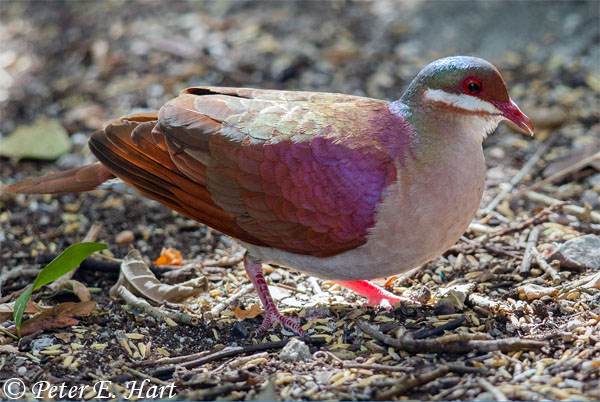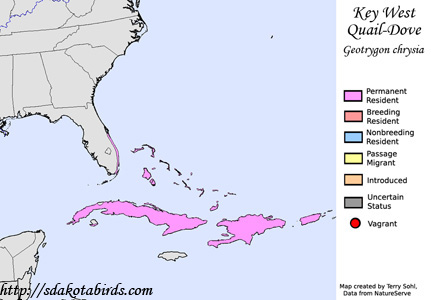| Length: 10-12 inches | Wingspan: 15-17 inches | Seasonality: Non-resident in South Dakota |
| ID Keys: Dark ruddy-brown back and wings, light-gray underparts, brownish head with white mustache and chin, iridescence on many upper feathers | ||
 The
Key West Quail-Dove is a medium sized dove of the Caribbean. They once
nested on Key West (the location where they were first identified and named)
and other locations in southern Florida, but are now primarily found on
islands of the Caribbean including Cuba and Puerto Rico. In Florida,
they are now only rare visitors. In their core range in the Caribbean
they are often relatively common, but given their shy nature and tendency to
stay in dense vegetation, they are often difficult to observe.
The
Key West Quail-Dove is a medium sized dove of the Caribbean. They once
nested on Key West (the location where they were first identified and named)
and other locations in southern Florida, but are now primarily found on
islands of the Caribbean including Cuba and Puerto Rico. In Florida,
they are now only rare visitors. In their core range in the Caribbean
they are often relatively common, but given their shy nature and tendency to
stay in dense vegetation, they are often difficult to observe.
Habitat: Found in a variety of tropical to sub-tropical woodlands and forests, as well as shrublands with dense vegetation.
Diet: Feeds on fallen fruits, berries and seeds, but will also take insects, and has often been seen feeding on snails.
Behavior: Forages by walking on the ground, typically in and around areas of vegetation. Items are gathered by plucking them off of the surface of the ground. When disturbed, they typically will run away on the ground, or make very short flights.
Nesting: The nest of Key West Quail-Dove is a simple platform of sticks and leaves, constructed on the ground or in a low shrub. The female lays one to three eggs, and both the male and female help to incubate them. The eggs hatch after about 12 days.
Song: A mournful, long groaning coo.
Migration: Considered a permanent resident throughout its normal range.
Interactive eBird map: Click here to access an interactive eBird map of Key West Quail-Dove sightings
Similar Species: Distinctive if seen well, although body shape suggests other pigeon and dove species.
Conservation Status: Population trends appear to be stable, the species is found over a relatively wide geographic area with many distinct populations, and they are common in parts of their range. The IUCN lists the Key West Quail-Dove as a species of "Least Concern".
Further Information: 1) WhatBird - Key West Quail-Dove
2) Cornell's NeoTropical Birds - Key West Quail-Dove
3) American Birds - A History of the Key West Quail-Dove in the United States
Photo Information: Photo taken by Peter E. Hart - Photo licensed under Creative Commons Attribution ShareAlike 2.0 Generic License.
| Click below for a higher-resolution map |
 |
| South Dakota Status: Non-resident in South Dakota |
Additional Key West Quail-Dove Photos (coming soon!!)
